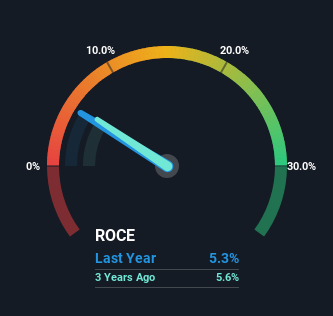Here's What's Concerning About Black Hills' (NYSE:BKH) Returns On Capital
If you're looking for a multi-bagger, there's a few things to keep an eye out for. Typically, we'll want to notice a trend of growing return on capital employed (ROCE) and alongside that, an expanding base of capital employed. Basically this means that a company has profitable initiatives that it can continue to reinvest in, which is a trait of a compounding machine. Having said that, from a first glance at Black Hills (NYSE:BKH) we aren't jumping out of our chairs at how returns are trending, but let's have a deeper look.
Return On Capital Employed (ROCE): What Is It?
For those that aren't sure what ROCE is, it measures the amount of pre-tax profits a company can generate from the capital employed in its business. To calculate this metric for Black Hills, this is the formula:
Return on Capital Employed = Earnings Before Interest and Tax (EBIT) ÷ (Total Assets - Current Liabilities)
0.053 = US$443m ÷ (US$9.4b - US$978m) (Based on the trailing twelve months to June 2023).
Thus, Black Hills has an ROCE of 5.3%. Even though it's in line with the industry average of 5.1%, it's still a low return by itself.
Check out our latest analysis for Black Hills
Above you can see how the current ROCE for Black Hills compares to its prior returns on capital, but there's only so much you can tell from the past. If you're interested, you can view the analysts predictions in our free report on analyst forecasts for the company.
What Can We Tell From Black Hills' ROCE Trend?
On the surface, the trend of ROCE at Black Hills doesn't inspire confidence. Over the last five years, returns on capital have decreased to 5.3% from 7.1% five years ago. Although, given both revenue and the amount of assets employed in the business have increased, it could suggest the company is investing in growth, and the extra capital has led to a short-term reduction in ROCE. And if the increased capital generates additional returns, the business, and thus shareholders, will benefit in the long run.
The Bottom Line On Black Hills' ROCE
While returns have fallen for Black Hills in recent times, we're encouraged to see that sales are growing and that the business is reinvesting in its operations. In light of this, the stock has only gained 11% over the last five years. Therefore we'd recommend looking further into this stock to confirm if it has the makings of a good investment.
Black Hills does have some risks, we noticed 4 warning signs (and 1 which can't be ignored) we think you should know about.
While Black Hills may not currently earn the highest returns, we've compiled a list of companies that currently earn more than 25% return on equity. Check out this free list here.
Have feedback on this article? Concerned about the content? Get in touch with us directly. Alternatively, email editorial-team (at) simplywallst.com.
This article by Simply Wall St is general in nature. We provide commentary based on historical data and analyst forecasts only using an unbiased methodology and our articles are not intended to be financial advice. It does not constitute a recommendation to buy or sell any stock, and does not take account of your objectives, or your financial situation. We aim to bring you long-term focused analysis driven by fundamental data. Note that our analysis may not factor in the latest price-sensitive company announcements or qualitative material. Simply Wall St has no position in any stocks mentioned.

